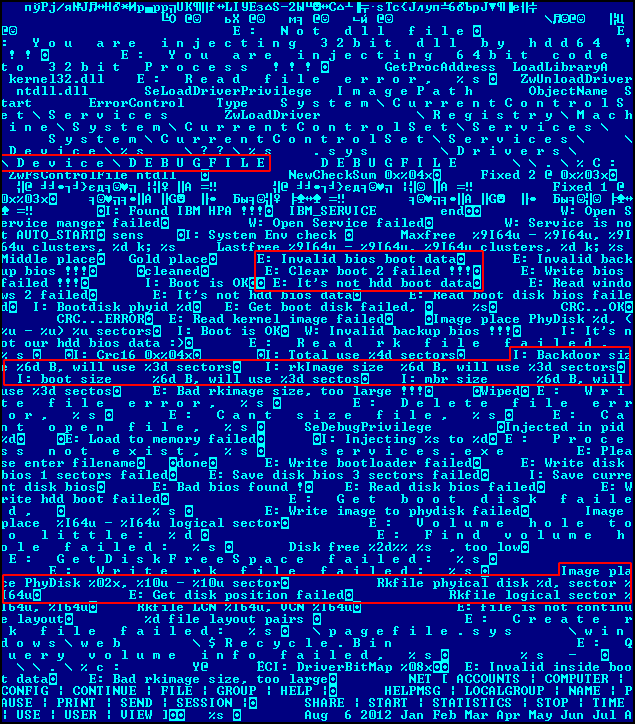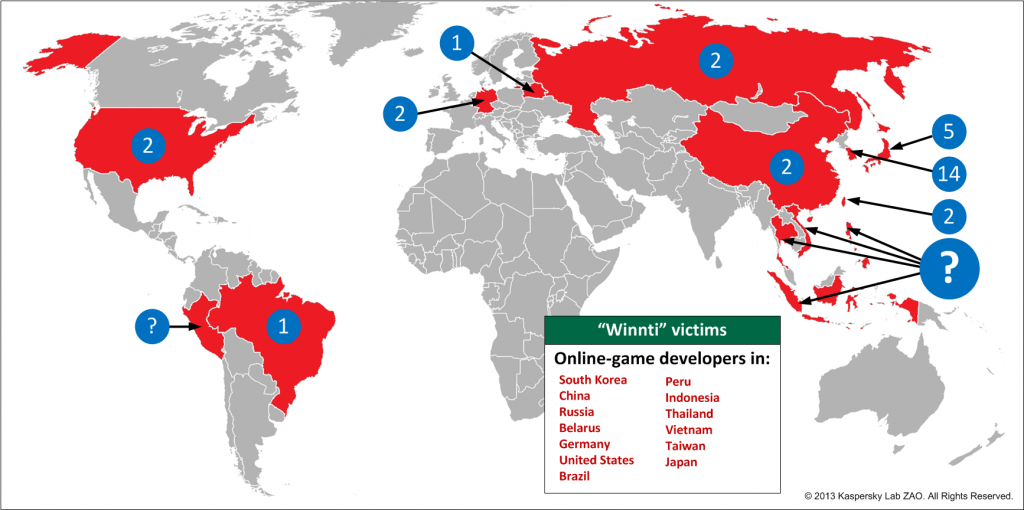Researchers at Kaspersky Lab have recently published a report, focused on a cyber-espionage campaign strategized by a hacker organization dubbed the Winnti group. Winnti has been attacking enterprises in the online video game field since 2009. The bad news is the group is active again, this time targeting digital certificates signed by big software providers to conduct intellectual property theft. The source code of several game projects is also endangered by the hacking team.
Image Source: Secure List
What Tools Does Winnti Employ?
Winnti 1.x and 2.x
According to Kaspersky, the group has been using a piece of malicious code which is called Winnti as well. Researchers have divided all the variants of the tool into two generations – 1.x and 2.x. More about the creation and usage of Winnti malware, you can read in the Winnti tool report by SecureList.
HDRoot/ HDD Rootkit
The newest threat traced back to the Winnti group is called HDRoot and is based on a 2006 bootkit installer.
What Is a Bootkit?
A bootkit is a boot virus designed to hook and patch Windows, and then get loaded into the Windows Kernel. Due to these malicious capabilities, the bootkit gets unlimited access to the machine. Because the Master Boot Record is not encrypted, a bootkit may avoid full volume encryption.
HDRoot is described as ‘a universal platform for a sustainable and persistent appearance in a targeted system’. What is worse, it can be employed as a foothold for any hacker’s tool.
HDRoot is used for cyber-espionage and intellectual property theft. It was discovered ‘by accident’ – when a sample of malware drew the attention of GReAT (Kaspersky Lab’s Global Research and Analysis Team). What intrigued the researchers was:
- The way this particular malware piece was protected with a commercial VMProtect Win64 executable and signed with a compromised certificate that belongs to a Chinese entity – Guangzhou YuanLuo Technology.
- The fact that the malware was spoofed to look like a Microsoft’s Net Command net.exe.
HDRoot Malicious Capabilities and Targets
Those two factors made the malware sample quite suspicious. At a later stage of the analysis, Kaspersky experts revealed that the HDRoot bootkit could be used to launch other malicious tools. To be more specific, two types of backdoor malware were identified. One of them could bypass detection by professional anti-virus software in South Korea – AhnLab’s V3 Lite, AhnLab’s V3 365 Clinic and ESTsoft’s ALYac. Hence, a conclusion was reached – the Winnti team used the backdoor to attack targets in South Korea.
Kaspersky researchers consider the probability that the Winnti organization has primary interests in South East Asia. Some of its other targets are likely situated in Japan, China, Bangladesh and Indonesia. HDRoot infections have been also detected in the United Kingdom and Russia.
Image Source: Secure List
The geography of the targets is probably related to the Winnti attackers home country and their interest in local software entities. It may be that the hackers wanted to obtain access to popular local companies. However, the reasons they had (and still may have) are not quite clear yet.
Researches also consider the possibility that the HDD Rootkit has been created by someone who joined the Winnti group, after he had written the bookit. Another scenario is that the hackers used third-party code, which was available on the Chinese cyber black market. What is more, once Kaspersky spotted the attack by Winnti and started analyzing it, the group immediately took action and adapted it. The result – in a couple of weeks, a new variant of the threat was identified. The attack is still active.
How Are the Winnti/ HDRoot Attacks Initiated?
Researchers believe that most of the attacks are initiated with a phishing email sent to one or more company mailboxes. The email messages typically contain malicious attachments in self-extracting or a regular archive with an executable file. Exploitation of zero-day vulnerabilities has not been observed. Once the targeted company is penetrated, the Winnti group uploads a set of tools on the compromised computer and starts scanning the network resources.
Then, they escalate privileges and locate whatever information is valuable in the particular company. Next, stolen data is exfiltrated in compressed form to one of Winnti’s control & command servers. For that purpose, a back-connect TCP channel through a chain of TCP-proxy apps is used, as disclosed by researchers.
According to researchers at Kaspersky Lab, their products can successfully block HDRoot and protect users.
***
To avoid being compromised by malicious software, sustain a powerful AV solution.
SpyHunter scanner will only detect the threat. If you want the threat to be automatically removed, you need to purchase the full version of the anti-malware tool.Find Out More About SpyHunter Anti-Malware Tool / How to Uninstall SpyHunter
Preparation before removing HDRoot Bootkit.
Before starting the actual removal process, we recommend that you do the following preparation steps.
- Make sure you have these instructions always open and in front of your eyes.
- Do a backup of all of your files, even if they could be damaged. You should back up your data with a cloud backup solution and insure your files against any type of loss, even from the most severe threats.
- Be patient as this could take a while.
- Scan for Malware
- Fix Registries
- Remove Virus Files
Step 1: Scan for HDRoot Bootkit with SpyHunter Anti-Malware Tool



Step 2: Clean any registries, created by HDRoot Bootkit on your computer.
The usually targeted registries of Windows machines are the following:
- HKEY_LOCAL_MACHINE\Software\Microsoft\Windows\CurrentVersion\Run
- HKEY_CURRENT_USER\Software\Microsoft\Windows\CurrentVersion\Run
- HKEY_LOCAL_MACHINE\Software\Microsoft\Windows\CurrentVersion\RunOnce
- HKEY_CURRENT_USER\Software\Microsoft\Windows\CurrentVersion\RunOnce
You can access them by opening the Windows registry editor and deleting any values, created by HDRoot Bootkit there. This can happen by following the steps underneath:


 Tip: To find a virus-created value, you can right-click on it and click "Modify" to see which file it is set to run. If this is the virus file location, remove the value.
Tip: To find a virus-created value, you can right-click on it and click "Modify" to see which file it is set to run. If this is the virus file location, remove the value.Step 3: Find virus files created by HDRoot Bootkit on your PC.
1.For Windows 8, 8.1 and 10.
For Newer Windows Operating Systems
1: On your keyboard press + R and write explorer.exe in the Run text box and then click on the Ok button.

2: Click on your PC from the quick access bar. This is usually an icon with a monitor and its name is either “My Computer”, “My PC” or “This PC” or whatever you have named it.

3: Navigate to the search box in the top-right of your PC's screen and type “fileextension:” and after which type the file extension. If you are looking for malicious executables, an example may be "fileextension:exe". After doing that, leave a space and type the file name you believe the malware has created. Here is how it may appear if your file has been found:

N.B. We recommend to wait for the green loading bar in the navigation box to fill up in case the PC is looking for the file and hasn't found it yet.
2.For Windows XP, Vista, and 7.
For Older Windows Operating Systems
In older Windows OS's the conventional approach should be the effective one:
1: Click on the Start Menu icon (usually on your bottom-left) and then choose the Search preference.

2: After the search window appears, choose More Advanced Options from the search assistant box. Another way is by clicking on All Files and Folders.

3: After that type the name of the file you are looking for and click on the Search button. This might take some time after which results will appear. If you have found the malicious file, you may copy or open its location by right-clicking on it.
Now you should be able to discover any file on Windows as long as it is on your hard drive and is not concealed via special software.
HDRoot Bootkit FAQ
What Does HDRoot Bootkit Trojan Do?
The HDRoot Bootkit Trojan is a malicious computer program designed to disrupt, damage, or gain unauthorized access to a computer system. It can be used to steal sensitive data, gain control over a system, or launch other malicious activities.
Can Trojans Steal Passwords?
Yes, Trojans, like HDRoot Bootkit, can steal passwords. These malicious programs are designed to gain access to a user's computer, spy on victims and steal sensitive information such as banking details and passwords.
Can HDRoot Bootkit Trojan Hide Itself?
Yes, it can. A Trojan can use various techniques to mask itself, including rootkits, encryption, and obfuscation, to hide from security scanners and evade detection.
Can a Trojan be Removed by Factory Reset?
Yes, a Trojan can be removed by factory resetting your device. This is because it will restore the device to its original state, eliminating any malicious software that may have been installed. Bear in mind that there are more sophisticated Trojans that leave backdoors and reinfect even after a factory reset.
Can HDRoot Bootkit Trojan Infect WiFi?
Yes, it is possible for a Trojan to infect WiFi networks. When a user connects to the infected network, the Trojan can spread to other connected devices and can access sensitive information on the network.
Can Trojans Be Deleted?
Yes, Trojans can be deleted. This is typically done by running a powerful anti-virus or anti-malware program that is designed to detect and remove malicious files. In some cases, manual deletion of the Trojan may also be necessary.
Can Trojans Steal Files?
Yes, Trojans can steal files if they are installed on a computer. This is done by allowing the malware author or user to gain access to the computer and then steal the files stored on it.
Which Anti-Malware Can Remove Trojans?
Anti-malware programs such as SpyHunter are capable of scanning for and removing Trojans from your computer. It is important to keep your anti-malware up to date and regularly scan your system for any malicious software.
Can Trojans Infect USB?
Yes, Trojans can infect USB devices. USB Trojans typically spread through malicious files downloaded from the internet or shared via email, allowing the hacker to gain access to a user's confidential data.
About the HDRoot Bootkit Research
The content we publish on SensorsTechForum.com, this HDRoot Bootkit how-to removal guide included, is the outcome of extensive research, hard work and our team’s devotion to help you remove the specific trojan problem.
How did we conduct the research on HDRoot Bootkit?
Please note that our research is based on an independent investigation. We are in contact with independent security researchers, thanks to which we receive daily updates on the latest malware definitions, including the various types of trojans (backdoor, downloader, infostealer, ransom, etc.)
Furthermore, the research behind the HDRoot Bootkit threat is backed with VirusTotal.
To better understand the threat posed by trojans, please refer to the following articles which provide knowledgeable details.




